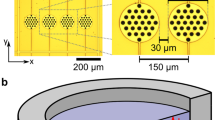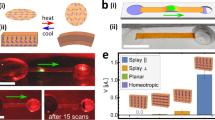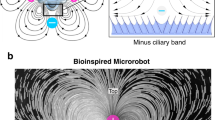Abstract
Cilial pumping is a powerful strategy used by biological organisms to control and manipulate fluids at the microscale. However, despite numerous recent advances in optically, magnetically and electrically driven actuation, development of an engineered cilial platform with the potential for applications has remained difficult to realize1,2,3,4,5,6. Here we report on active metasurfaces of electronically actuated artificial cilia that can create arbitrary flow patterns in liquids near a surface. We first create voltage-actuated cilia that generate non-reciprocal motions to drive surface flows at tens of microns per second at actuation voltages of 1 volt. We then show that a cilia unit cell can locally create a range of elemental flow geometries. By combining these unit cells, we create an active cilia metasurface that can generate and switch between any desired surface flow pattern. Finally, we integrate the cilia with a light-powered complementary metal–oxide–semiconductor (CMOS) clock circuit to demonstrate wireless operation. As a proof of concept, we use this circuit to output voltage pulses with various phase delays to demonstrate improved pumping efficiency using metachronal waves. These powerful results, demonstrated experimentally and confirmed using theoretical computations, illustrate a pathway towards fine-scale microfluidic manipulation, with applications from microfluidic pumping to microrobotic locomotion.
This is a preview of subscription content, access via your institution
Access options
Access Nature and 54 other Nature Portfolio journals
Get Nature+, our best-value online-access subscription
$29.99 / 30 days
cancel any time
Subscribe to this journal
Receive 51 print issues and online access
$199.00 per year
only $3.90 per issue
Buy this article
- Purchase on Springer Link
- Instant access to full article PDF
Prices may be subject to local taxes which are calculated during checkout




Similar content being viewed by others
Data availability
All data needed to evaluate the conclusions in the paper are present in the paper or the Supplementary Information. Source data are provided with this paper.
Code availability
All code needed to evaluate the conclusions in the paper are present in the paper or the Supplementary Information.
References
Thorsen, T., Maerkl, S. J. & Quake, S. R. Microfluidic large-scale integration. Science 298, 580–584 (2002).
den Toonder, J. M. J. & Onck, P. R. Microfluidic manipulation with artificial/bioinspired cilia. Trends Biotechnol. 31, 85–91 (2013).
Lee, C.-Y., Chang, C.-L., Wang, Y.-N. & Fu, L.-M. Microfluidic mixing: a review. Int. J. Mol. Sci. 12, 3263–3287 (2011).
Gu, H. et al. Magnetic cilia carpets with programmable metachronal waves. Nat. Commun. 11, 2637 (2020).
Wang, Y., den Toonder, J., Cardinaels, R. & Anderson, P. A continuous roll-pulling approach for the fabrication of magnetic artificial cilia with microfluidic pumping capability. Lab Chip 16, 2277–2286 (2016).
Iverson, B. D. & Garimella, S. V. Recent advances in microscale pumping technologies: a review and evaluation. Microfluid. Nanofluid. 5, 145–174 (2008).
Blake, J. R. & Sleigh, M. A. Mechanics of ciliary locomotion. Biol. Rev. 49, 85–125 (1974).
Van Houten, J. Two mechanisms of chemotaxis in Paramecium. J. Comp. Physiol. 127, 167–174 (1978).
Sleigh, M. A., Blake, J. R. & Liron, N. The propulsion of mucus by cilia. Am. Rev. Respir. Dis. 137, 726–741 (1988).
Lauga, E. & Powers, T. R. The hydrodynamics of swimming microorganisms. Rep. Prog. Phys. 72, 096601 (2009).
Lauga, E. Propulsion in a viscoelastic fluid. Phys. Fluids 19, 083104 (2007).
Satir, P., Heuser, T. & Sale, W. S. A structural basis for how motile cilia beat. BioScience 64, 1073–1083 (2014).
Sanchez, T., Welch, D., Nicastro, D. & Dogic, Z. Cilia-like beating of active microtubule bundles. Science 333, 456–459 (2011).
Zhang, X., Guo, J., Fu, X., Zhang, D. & Zhao, Y. Tailoring flexible arrays for artificial cilia actuators. Adv. Intell. Syst. 3, 2000225 (2020).
Milana, E. et al. Metachronal patterns in artificial cilia for low Reynolds number fluid propulsion. Sci. Adv. 6, eabd2508 (2020).
van Oosten, C. L., Bastiaansen, C. W. & Broer, D. J. Printed artificial cilia from liquid-crystal network actuators modularly driven by light. Nat. Mater. 8, 677–682 (2009).
Li, M., Kim, T., Guidetti, G., Wang, Y. & Omenetto, F. G. Optomechanically actuated microcilia for locally reconfigurable surfaces. Adv. Mater. 32, 2004147 (2020).
den Toonder, J. et al. Artificial cilia for active micro-fluidic mixing. Lab Chip 8, 533–541 (2008).
Vilfan, M. et al. Self-assembled artificial cilia. Proc. Natl Acad. Sci. 107, 1844–1847 (2010).
Khaderi, S. N., den Toonder, J. M. J. & Onck, P. R. Magnetic artificial cilia for microfluidic propulsion. Adv. Appl. Mech. 48, 1–78 (2015).
Friese, M. E. J., Rubinsztein-Dunlop, H., Gold, J., Hagberg, P. & Hanstorp, D. Optically driven micromachine elements. Appl. Phys. Lett. 78, 547–549 (2001).
Zhang, S., Cui, Z., Wang, Y. & den Toonder, J. M. Metachronal actuation of microscopic magnetic artificial cilia generates strong microfluidic pumping. Lab Chip 20, 3569–3581 (2020).
Dong, X. et al. Bioinspired cilia arrays with programmable nonreciprocal motion and metachronal coordination. Sci. Adv. 6, eabc9323 (2020).
Chen, C.-Y., Chen, C.-Y., Lin, C.-Y. & Hu, Y.-T. Magnetically actuated artificial cilia for optimum mixing performance in microfluidics. Lab Chip 13, 2834–2839 (2013).
Miskin, M. Z. et al. Electronically integrated, mass-manufactured, microscopic robots. Nature 584, 557–561 (2020).
Liu, Q. et al. Micrometer-sized electrically programmable shape-memory actuators for low-power microrobotics. Sci. Robot. 6, eabe6663 (2021).
Purcell, E. M. Life at low Reynolds number. Am. J. Phys. 45, 3–11 (1977).
Machin, K. E. Wave propagation along flagella. J. Exp. Biol. 35, 796–806 (1958).
Wiggins, C. H. & Goldstein, R. E. Flexive and propulsive dynamics of elastica at low Reynolds number. Phys. Rev. Lett. 80, 3879–3882 (1998).
Dreyfus, R. et al. Microscopic artificial swimmers. Nature 437, 862–865 (2005).
Khaderi, S. N., Baltussen, M. G. H. M., Anderson, P. D., den Toonder, J. M. J. & Onck, P. R. Breaking of symmetry in microfluidic propulsion driven by artificial cilia. Phys. Rev. E 82, 027302 (2010).
Yu, T. S., Lauga, E. & Hosoi, A. E. Experimental investigations of elastic tail propulsion at low Reynolds number. Phys. Fluids 18, 091701 (2006).
Lauga, E. The Fluid Dynamics of Cell Motility (Cambridge Univ. Press, 2020).
Cox, R. G. The motion of long slender bodies in a viscous fluid. Part 1. General theory. J. Fluid Mech. 44, 791–810 (1970).
De Canio, G., Lauga, E. & Goldstein, R. E. Spontaneous oscillations of elastic filaments induced by molecular motors. J. R. Soc. Interface 14, 20170491 (2017).
Quennouz, N., Shelley, M., du Roure, O. & Lindner, A. Transport and buckling dynamics of an elastic fibre in a viscous cellular flow. J. Fluid Mech. 769, 387–402 (2015).
Blake, J. R. A note on the image system for a stokeslet in a no-slip boundary. Math. Proc. Cambridge Philos. Soc. 70, 303–310 (1971).
Khaderi, S. N., den Toonder, J. M. J. & Onck, P. R. Microfluidic propulsion by the metachronal beating of magnetic artificial cilia: a numerical analysis. J. Fluid Mech. 688, 44–65 (2011).
Powers, T. R. Dynamics of filaments and membranes in a viscous fluid. Rev. Mod. Phys. 82, 1607–1631 (2010).
Audoly, B. & Pomeau, Y. Elasticity and Geometry: From Hair Curls to the Non-linear Response of Shells (Oxford Univ. Press, 2010).
Liron, N. & Mochon, S. Stokes flow for a stokeslet between two parallel flat plates. J. Eng. Math. 10, 287–303 (1976).
Cortez, R. The method of regularized stokeslets. SIAM J. Sci. Comput. 23, 1204–1225 (2001).
Acknowledgements
We thank D. Koch, B. Bircan, K. Dorsey, T. Ma, T. Pearson, S. Norris and Y. Yang for discussions, and T. Pennell, J. Clark, V. Genova and G. Bordonaro for technical support. This work was supported by the Army Research Office (ARO W911NF-18-1-0032), the National Science Foundation (EFMA-1935252), the Cornell Center for Materials Research (DMR-1719875), the Air Force Office of Scientific Research (MURI: FA9550-16-1-0031), and the Kavli Institute at Cornell for Nanoscale Science. This project has also received funding from the European Research Council under the European Union’s Horizon 2020 Research and Innovation Programme (grant no. 682754) and from Trinity College, Cambridge (IGS scholarship). This work was performed in part at Cornell NanoScale Facility, an NNCI member supported by NSF Grant NNCI-2025233.
Author information
Authors and Affiliations
Contributions
W.W., Q.L., M.Z.M. and I.C. conceived the experiments. W.W. and Q.L. designed and fabricated the surface electrochemical actuators, carried out the experiments, and collected and analysed the data. Q.L., W.W., M.F.R. and M.Z.M. developed the fabrication procedure for the platinum actuator. M.C.C., Q.L. and D.A.M. conducted the STEM imaging. A.J.C., M.F.R. and A.C.M. designed the CMOS clock circuit. W.W., Q.L. and M.F.R. determined the fabrication procedure for integrating the CMOS and surface electrochemical actuators. I.T. and E.L. conducted all of the simulations to determine the flow trajectories. W.W., I.T., E.L., P.L.M. and I.C. wrote the manuscript with contributions from all authors.
Corresponding authors
Ethics declarations
Competing interests
The authors declare no competing interests.
Peer review
Peer review information
Nature thanks the anonymous reviewers for their contribution to the peer review of this work. Peer reviewer reports are available.
Additional information
Publisher’s note Springer Nature remains neutral with regard to jurisdictional claims in published maps and institutional affiliations.
Extended data figures and tables
Extended Data Fig. 1 Fabrication process of an artificial cilium.
180-nm Al and 20-nm Al2O3 were first grown and patterned as the release layer. 3-nm Ti and 7-nm Pt were then grown and patterned as the actuator. Finally, several polymer panels were patterned on the actuator to prevent twisting of the cilium.
Extended Data Fig. 2 Cyclic voltammetry of artificial cilia.
The cyclic voltammetry curve for an artificial cilium actuated between −0.2 V to 1 V at a sweep rate of 1 V s−1, the peak current density is about 1 mA cm−2.
Extended Data Fig. 3 Durability of artificial cilia.
Shown is the relative velocity versus the number of actuation cycles. The relative velocity is scaled by the initial pumping velocity. We find no obvious decay after 1,000 actuation cycles. The linear fit to the data indicates that the relative velocity will decrease by 50% after approximately 20,000 actuation cycles.
Extended Data Fig. 4 Pumping efficiency in simulation and experiment.
a, A cilium beating at around 1 Hz, corresponding to a Sperm number of 1. At these low Sperm numbers, the viscous force is not large enough to break the actuation symmetry. b, A cilium beating at around 230 Hz, corresponding to a Sperm number of 7. At these high Sperm numbers viscous drag is too large, diminishing the motion of the cilia. c, The relationship between pumping efficiency, displaced volume, and Sperm number. The pumping efficiency is defined as the ratio between the area covered by the cilium tip and the square of the length of cilium. d, The relationship between Sperm number and the actuation frequency for cilia with different lengths. The blue shaded region roughly indicates the maximal pumping velocities measured in the experiments.
Extended Data Fig. 5 A microscopic device for measuring the trajectory of one cilium.
We at first apply a fixed voltage on the hinge through electrode 1 to make the hinge bend up to about 90°, then apply another oscillating voltage through electrode 2 to actuate the cilium.
Extended Data Fig. 6 Two-hinge cilium.
a, Optical image of a fabricated two-hinge cilium. b, A 3D rendering of the two-hinge cilium that defines the segment lengths and hinge angles. c, The actuation sequences that maximize swept area (blue shaded region) for the two-hinge cilium. d, The positions of several representative particles (marked with yellow, red, and green circles) after 0, 1 and 2 cycles of actuations (from left to right). e, The pumping distance per cycle for a two-hinge cilium operating at 0.5 Hz and a one-hinge cilium operating at 10 Hz. The data show the mean pumping distance averaged over five separatemeasurements. The error bars indicate the standard deviation. Scale bars, 20 μm.
Extended Data Fig. 7 Comparison of the streamlines for various cilia activation patterns.
Included are open channels without a top wall (top) and closed channels with a top wall (bottom). All the figures are obtained through numerical simulations. We find that the qualitative features of the streamlines are preserved when the top wall is added. The parts of the streamlines that deviate from the single-wall case the most are located exactly where the regularized singularities are located, and therefore where the simulation error is largest. The biggest change occurs for the expansion flows, which are inherently 3D. These simulation results suggest thus that the tessellation idea will work in a channel geometry as well.
Extended Data Fig. 8 An experimental set-up of computer-controlled cilia metasurface chip.
We used a LabVIEW programme to generate voltage signals and send these signals to the data-acquisition device. The output of the data-acquisition device was connected to the cilia metasurface through a breadboard and a chip carrier.
Extended Data Fig. 9 Fabrication process for untethered artificial cilia integrated with CMOS circuit.
The orange and yellow zones represent the photovoltaics and the output pins that are used to set the frequency and interconnect to the cilia. Both structures are prefabricated by X-FAB. 180-nm Al and 30-nm Al2O3 were first grown and patterned as the release layers. The metal contacts were then etched and exposed. Ti/Pt interconnects were patterned to wire the contacts. A protective SiO2 layer was grown and patterned to prevent electrical shorts and current leaks. A Cr shielding layer was fabricated to protect the circuit from the light. Actuator layers that consist of Ti and Pt were grown and patterned. Finally, polymer panels were patterned on the actuator.
Extended Data Fig. 10 CMOS circuit.
a, An optical image of the integrated circuit. The circuit outputs up to eight square waves with phase delays to drive the actuators. We set the frequency by hard wiring, the available frequency ranges from 2 Hz to 256 Hz. b, Block diagram of the circuit. c, Current versus time outputs from the circuit under different light intensities. The output current ranges from 140 nA under a light intensity of 1 kW m−2 equivalent to 1 sun, to about 880 nA at a light intensity of 5 suns. Scale bars: 20 μm (a), 0.3 μA (c, vertical), 0.05 s (c, horizontal).
Supplementary information
Supplementary Code 1
This MATLAB app allows the user to determine the flow patterns that result from any combination of active cilia arrays on the metasurface. This code works in MATLAB 2020 and newer versions.
Supplementary Video 1
| Real time video of actuating cilia arrays. The cilia are actuated at 2 Hz by sweeping the voltage between −0.2 V to 1 V during each cycle.
Supplementary Video 2
| An experiment showing the trajectory of a 50-µm long cilium driven at an actuation frequency of 40 Hz. The hinged stage at the bottom rotates the cilium stroke plane by 90° so that we can observe it from the side.
Supplementary Video 3
| The simulated trajectory of a 50-µm long cilium driven at an actuation frequency of 40 Hz.
Supplementary Video 4
| The pumping of a two-hinge cilium at an actuation frequency of 0.5 Hz. This video is presented in real time.
Supplementary Video 5
| The trajectories of fluorescent tracer particles in an extensional surface flow geometry. The focal plane resides near the cilia tips. This video is presented in real time.
Supplementary Video 6
| A rotational flow switching its direction from clockwise to counter-clockwise by programming the actuation of the cilia metasurface. This video is presented in real time.
Supplementary Video 7
| CMOS integrated artificial cilia arrays actuated with π/2 phase delay, particles are used to track the flow field. This video is presented in real time.
Supplementary Video 8
|The actuation of actuators in a broad range of pH conditions. This video is presented in real time.
Rights and permissions
About this article
Cite this article
Wang, W., Liu, Q., Tanasijevic, I. et al. Cilia metasurfaces for electronically programmable microfluidic manipulation. Nature 605, 681–686 (2022). https://doi.org/10.1038/s41586-022-04645-w
Received:
Accepted:
Published:
Issue Date:
DOI: https://doi.org/10.1038/s41586-022-04645-w
This article is cited by
-
Reconfigurable flexible metasurfaces: from fundamentals towards biomedical applications
PhotoniX (2024)
-
Artificial-goosebump-driven microactuation
Nature Materials (2024)
-
Clinical translation of wireless soft robotic medical devices
Nature Reviews Bioengineering (2024)
-
Bioinspired magnetic cilia: from materials to applications
Microsystems & Nanoengineering (2023)
-
Optimal free-surface pumping by an undulating carpet
Nature Communications (2023)
Comments
By submitting a comment you agree to abide by our Terms and Community Guidelines. If you find something abusive or that does not comply with our terms or guidelines please flag it as inappropriate.



